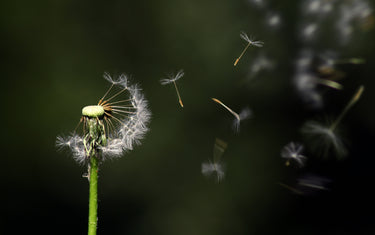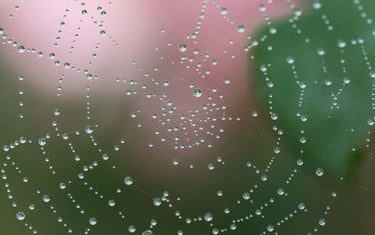5 min read / 1 May 2024 / yasmin sharp
Best Essential Oils for Hay Fever
Learn how to safely use essential oils as part of your hayfever treatment plan and get tips on incorporating them into your daily routine.
Share this post

Learn how to safely incorporate essential oils into your hay fever treatment plan and get tips on introducing them into your daily routine.
When hay fever season heightens between late March and September each year, many people who regularly struggle with the allergy often turn to over the counter products.
However, rather than relying on pharmaceuticals, you may find that using essential oils or aromatherapy oils for hay fever can offer the answer.
If you are looking for more natural allergy remedies to help tackle hay fever, read on to see what essential oils for hay fever you could use.
What is hay fever?Hay fever is an allergic reaction that affects people during certain periods of the year. Also known as seasonal rhinitis, it shares symptoms with year-round allergic rhinitis, although it occurs during the early spring and summer months as a reaction to pollen produced by grass, trees and weeds. The pollen count tends to be at its highest during months when it is warm, humid and windy, which is usually between late March and September. |

What essential oils can help to ease hay fever symptoms?
1. Eucalyptus
Hay fever often leads to a build-up in congestion which can make it difficult to breathe.
Eucalyptus oil is known as the ‘breathing oil’ due to its anti-inflammatory properties that can ease congestion and improve your breathing pattern.
Research is ongoing to determine further benefits it may be able to offer in addition to reducing allergic symptoms.
You could try diffusing eucalyptus essential oil into the air, so you breathe it in naturally, or try inhaling it directly from the bottle.
While eucalyptus can help with hay fever relief it can also trigger allergies in some people, so avoid using it if you are sensitive to the oil.
If you’re feeling congested check out the best essential oils for a blocked nose.
2. Rosemary
According to studies carried out by a leading university, the components found in rosemary could limit the process leading up to an allergic reaction.
The primary ingredient in rosemary oil was found to decrease immune cells, which meant less congestion.
This could be ideal for anyone who struggles to deal with the at-times intense congestion that builds up at the height of hay fever season.
Disperse the oil into the air using a diffuser, mix it with a carrier oil into a warm bath so you breathe it in with the vapours, or inhale directly from the bottle to help treat allergies.
3. Lavender
Lavender essential oil is used to treat all kinds of ailments, one of which is hay fever.
Its anti-inflammatory properties could work wonders for your sinuses and help provide hay fever relief.
According to the findings of one study, lavender essential oil not only prevented allergic inflammation, but also inhibited the expansion of mucous cells.
To enjoy the benefits of lavender oil, we’d suggest using it with a diffuser for aromatherapy or adding a few drops to your pillow at night, which will not only offer a gentle and natural treatment to hay fever but help you drift off to sleep more easily.
Find out more about essential oils for sinus congestion here.

4. Lemon
Lemons are high in alkaline, which can have a positive effect on the immune system by helping it to function more effectively.
They are also packed with Vitamin C and antioxidants, which offers all types of health-related benefits for your body.
If you are struggling with seasonal allergies, then using lemon essential oil could clear your sinuses and reduce congestion, which are two of the most common symptoms of hay fever.
Lemon is also a great mood and energy lifter, so why not try diffusing to enjoy its bright, citrusy aroma or diluting and applying it to your skin to ease your hay fever symptoms.
5. Peppermint
Many people use peppermint to deal with skin inflammation and its refreshing scent can also help to clear the nasal airwaves to improve your breathing.
There are lots of ways you can use peppermint essential oil, whether it’s using a diffuser to let it disperse into the air or mixing it with a carrier oil for skin application or mixing it into a bath.
Dealing with hay fever can be quite fatiguing, especially if it goes on for most of the day or consecutive days.
Peppermint essential oil is renowned for its ability to relieve stress and store energy levels, so it could prove to be the answer to your hay fever troubles.
Peppermint oil is one of the best essential oils for helping with sore or sensitive eyes, take a look at some of the other essential oils that are good for eyecare.
6. Tea tree
Like many of the essential oils mentioned in this blog, tea tree essential oil is also a recognised anti-inflammatory, and it may help to reduce your hay fever symptoms.
Many people rely on tea tree oil for dealing with skin-based allergies and when applied topically it could decrease swelling from histamine-induced skin inflammation.
Because tea tree is a relatively potent essential oil, we advise that it should only be used topically and not ingested.
You should also be aware that in some people it can induce allergic contact dermatitis.

How to use essential oils for hay fever
You can use high quality essential oils for allergies and hay fever in several ways, with some of the most popular including:
Diffusion
Use a diffuser with a few drops of oil so it can be released into the air. This can be very beneficial for treating seasonal allergies and other respiratory conditions.
Topical application
This refers to applying an essential oil directly to the skin after being mixed with a carrier oil.
People with skin allergies and symptoms such as rashes, itching and hives may benefit from this method.
Direct inhalation
You could also breathe in the oil directly from the bottle or add one or two drops to a handkerchief.
Or you can use essential oils for hay fever relief by adding a few drops to a hot bowl of water and breathing in the vapours.

Essential oils such as eucalyptus, tea tree and lemon can be used as a gentle and natural treatment to kill dust mites and moulds, which are known to trigger common allergy symptoms. These oils can act as natural antihistamines, helping to alleviate allergic reactions.
Mix 20 drops of essential oil with a tablespoon of white vinegar to one cup of water and apply this to areas of your home that are known to develop mould.
Essential oils and utilising aromatherapy for allergies could make all the difference to your hay fever symptoms when the pollen count starts to rise again, and you have a good variety to choose from.
What works best for you will depend on the severity of your symptoms and how your body reacts to the oil, but even if a particular oil does not quite do the trick, it can offer other vitamin and nutrient benefits.
Join Nikura's wholesale program and you can enjoy competitive pricing, no minimum order requirements, and an easy ordering process.
Sign up for a wholesale account here and take a look at our wholesale essential oils for hay fever.









